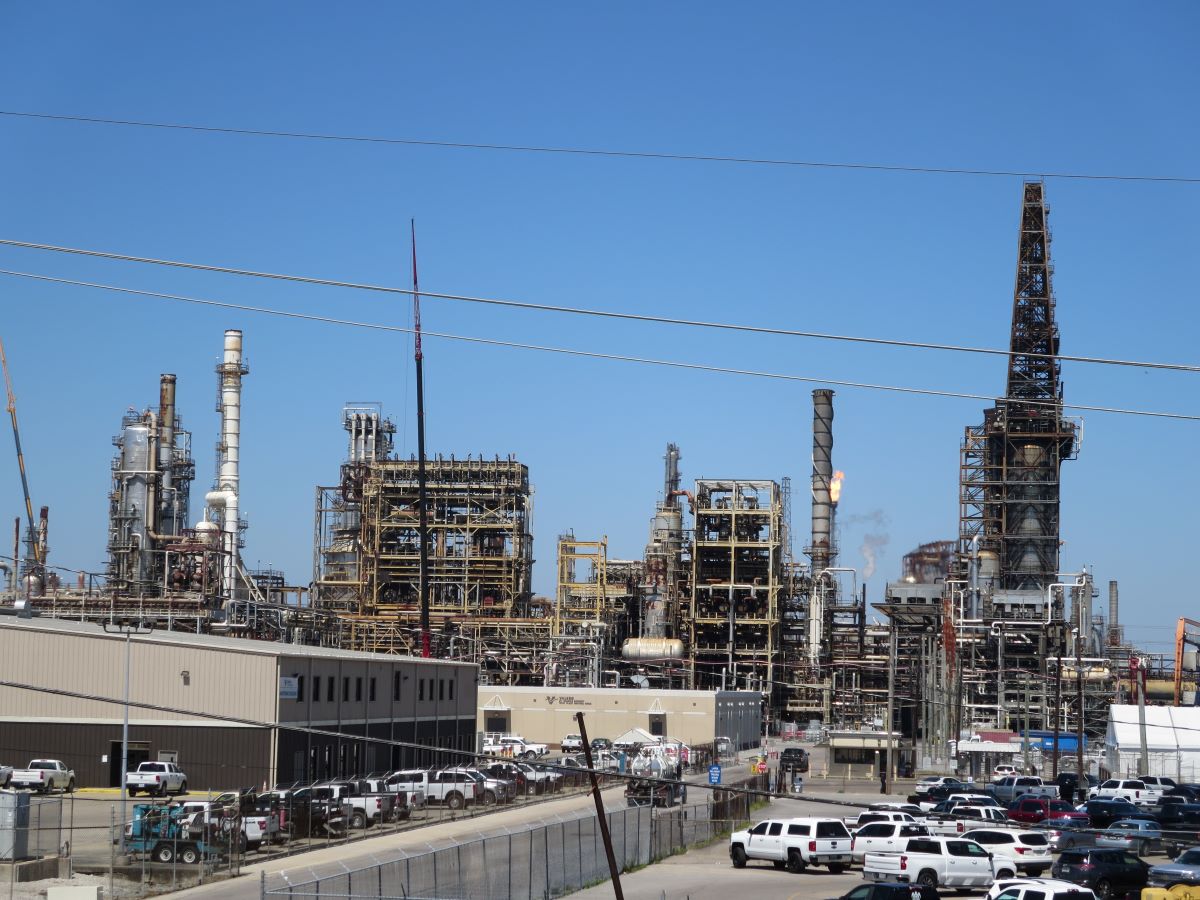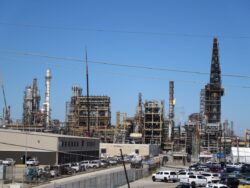Cancer Alley
Located along the Mississippi River in southeast Louisiana, Cancer Alley is home to the highest concentration of heavy industry in the United States, with residents reporting high rates of cancer, heart disease, respiratory illnesses, and autoimmune disease.

Louisiana Endowment for the Humanities
Petrochemical facilities in Norco, Louisiana. Photo by Erin Greenwald.
Since 1988 the term “Cancer Alley” has referred to the communities and land along the Mississippi River in southeast Louisiana. The phrase calls attention to the region’s status as a “sacrifice zone,” a label applied to geographies, often near communities of color, where industry’s economic benefits are prioritized over environmental and public health. More than two hundred petrochemical plants and oil refineries operate in the region, making it home to the highest concentration of heavy industry in the United States. Located on former plantation sites, these facilities often abut predominantly Black communities, including free towns established by formerly enslaved people, Union soldiers, and maroons in the aftermath of the Civil War. As a result, communities of color bear a significant body burden from industrial pollution, experiencing between seven to twenty-one times higher emissions rates, depending on the pollutant, than predominantly white communities. Residents of “Cancer Alley” report higher than average rates of cancer, heart disease, respiratory illnesses, and autoimmune disease. A 2022 study published in Environmental Research Letters found that toxic air pollution in Louisiana’s chemical corridor caused at least 850 cancer cases over the last ten years.
Note on Geographic Area
The boundaries of Cancer Alley vary depending on the source. While Cancer Alley is often described as an eighty-five-mile stretch of industrialized land between Baton Rouge and New Orleans, Kimberly Terrell, a research scientist at the Tulane Environmental Law Clinic, argues that the area is closer to 180 miles beginning in Pointe Coupee Parish and following the Mississippi River to the Gulf of Mexico.
A History of Extraction
In the decades leading up to the Civil War, the Mississippi River between New Orleans and Baton Rouge was lined on both sides with plantations that produced cotton, rice, and an extraordinary amount of sugar. Upon emancipation, the plantation system, which relied on the labor of enslaved Black workers, ended and agriculture slowed. Some former plantations maintained production while others folded. As the cost of sugar cane production mounted, riverside land became available for other uses.
In 1909, eight years after oil was discovered in Evangeline Parish, Standard Oil built the state’s largest oil refinery in Baton Rouge on the site of a former plantation, a precursor to the Exxon refinery that exists there to this day. Two years later Shell bought out the town of Sellers in St. Charles Parish and established the New Orleans Refining Company, changing the town name in 1926 to Norco. Much like the plantations that occupied the land previously, heavy industry along the Mississippi River benefitted from access to world-class shipping lanes and cheap labor. In the aftermath of World War II, the oil and gas industry boomed, becoming the driver of Louisiana’s economy, development, and politics. Drawn by record-breaking profits, lax environmental and labor laws, and property tax exemptions, global corporations bought large swaths of former plantation land, often locating refineries and petrochemical plants adjacent to historically Black free towns that had been established by formerly enslaved people and maroons in the aftermath of the Civil War.
Industrial development was largely welcomed by local communities, particularly Black workers seeking opportunities outside of low-paying agricultural work, which persisted through the 1980s. Notable plants from this era include: CF Industries’ “Donaldson Complex” in Ascension Parish, which opened in the 1960s and eventually became the largest ammonia producer in the world; Dupont’s synthetic rubber factory in St. John the Baptist Parish (now called Denka Performance Elastomer), which is the only producer of neoprene in the world; Bayer-AG’s plant in St. Charles Parish which produces the pesticide Round Up; and numerous vinyl chloride facilities. By the 1970s the region produced 60 percent of the nation’s vinyl chloride, 60 percent of US-made nitrogen fertilizers, and 26 percent of US-made chlorine.
Public Health and Activism
The name “Cancer Alley” arose as a series of public health tragedies in southeast Louisiana garnered national attention. In 1987 fifteen residents along two blocks of Jacobs Drive in Chalmette died of cancer, prompting residents to call the street Cancer Alley. Cancer clusters were also reported in the predominantly Black town of Geismer in Ascension Parish. And in the predominantly Black town of St. Gabriel, located within five miles of eighteen petrochemical plants, pharmacist Kay Gaudet collected the names of local women who experienced miscarriages, estimating that between 1983 and 1988, a third of pregnancies failed.
In 1988, as concerns over public health in Black riverside communities grew, local groups organized a protest march from Baton Rouge to New Orleans. As part of the “Great Louisiana Toxics March,” Greenpeace hung a twenty-five-foot banner depicting a check made out to the Louisiana legislature in “Cancer Alley, Louisiana.” The name “Cancer Alley” stuck.
Industrial buildout continued to boom, even as lawsuits mounted on behalf of sick workers, residents, and habitats. Increasingly grassroots organizations sought to protect public health from industrial pollution. In extreme cases residents fought for their homes to be purchased by industry at market rates. In the late 1980s the toxic chemical vinyl chloride was discovered in two historically Black free towns, and nearby industries bought out residents. Georgia Gulf Corp bought out Revielletown for $3 million in 1987, and Dow Chemical Company purchased Morrisonville for $7 million.
In 1989 Margie Richard founded the Concerned Citizens of Norco to organize against Shell Oil facilities operating on either side of the small Black neighborhood of Diamond. In addition to two fatal chemical explosions, residents of Diamond were developing the rare diseases scleroderma and sarcoidosis. With residents desperate to leave, Shell began buying up houses at below-market value. Meanwhile the Louisiana Bucket Brigade, a New Orleans-based nonprofit founded in 2001, assisted fence-line neighbors in collecting air samples, which revealed unreported toxic emissions from Shell facilities. After pressure from environmental groups, Shell agreed in 2001 to buy the properties of all Diamond residents for a minimum price of $80,000 per house. This was considered a major environmental victory. Nonetheless, the buyouts of Revielletown, Morrisonville, Diamond, and much of the Standard Heights neighborhood in East Baton Rouge created what some observers called a “dangerous precedent” in which companies could pay their way out of trouble rather than develop safer environmental practices.
During the early years of the COVID-19 pandemic, Rise St. James, a faith-based environmental organization under the leadership of Sharon Lavigne, brought renewed international attention to Cancer Alley and environmental racism as they mounted a successful campaign during the pandemic to stop Formosa Plastics from building a $9.4 billion complex. If built, Formosa’s facility would have been the world’s largest plastics facility.
In January 2021 Cancer Alley received national attention when President Joe Biden created a White House council on environmental justice, pledging that 40 percent of federal investments in clean energy and clean water would address “the disproportionate health and environmental and economic impacts on communities of color—so-called fence-line communities—especially . . . the hard-hit areas like Cancer Alley in Louisiana.” In 2023 the Department of Justice filed an “imminent and substantial endangerment” case on behalf of the Environmental Protection Agency against the Denka plant in St. John the Baptist Parish, where studies show nearby residents, including students of Fifth Ward Elementary School and East St. John High School have a cancer risk fifty times higher than the national average.
Additional Controversies
Black residents of Cancer Alley have long challenged the claim that industrial development provides jobs and economic benefits. While new industries create jobs that pay well above the median salary, residents note that the best-paying jobs go to white employees as well as employees from out of state, a claim supported by the simultaneous development of residential hotels.
Local tax revenue from industrial development in the region is another source of controversy. Since 1936 Louisiana has offered industry a 100 percent local property tax exemption for ten years. The stated goal of the Industrial Tax Exemption Program is to encourage industries to build in Louisiana and create jobs. In the wake of Hurricane Katrina and the Great Recession, scrutiny of the program has grown. The Louisiana Economic Development Program estimates that between 2008 and 2015, ITEP cost local governments $10 billion in property tax revenue, an amount that might not be offset by job creation. In 2016 Gov. John Bel Edwards reformed ITEP, giving parishes local approval over industrial property tax exemptions, limiting companies to an 80 percent exemption, and creating job requirements for participating plants.
Objections to the Name “Cancer Alley”
In 2021 Sen. Bill Cassidy called the name “Cancer Alley” “a slam upon our state.” In 2023 Head of Louisiana Chemical Association Greg Bowser published an op-ed stating, “Decades of data compiled by the Louisiana Tumor Registry (LTR)—a statewide registry of cancer incidences administered by LSU’s School of Public Health—shows there is no ‘Cancer Alley.’ . . . The science is clear: The ‘Cancer Alley’ moniker is unwarranted.” Scientists point out that Bowser’s claim relies on a misinterpretation of Louisiana Tumor Registry data, which does not analyze the impact of industrial emissions on cancer rates.
